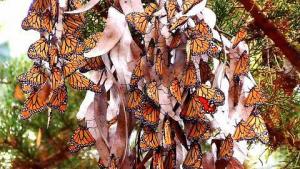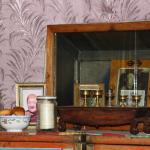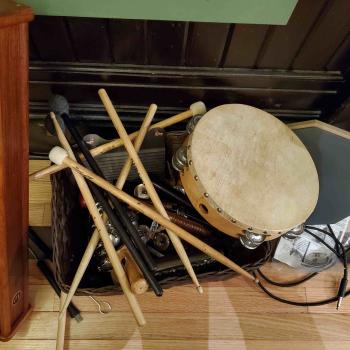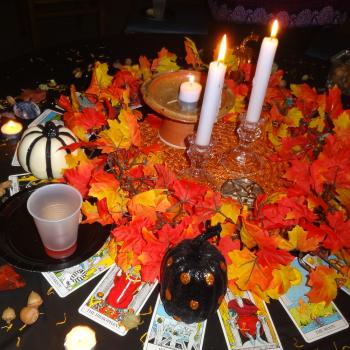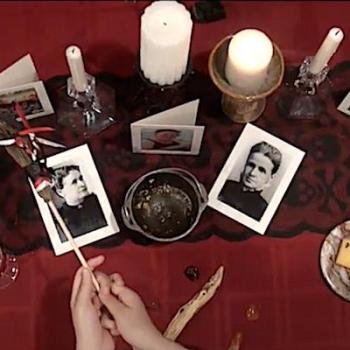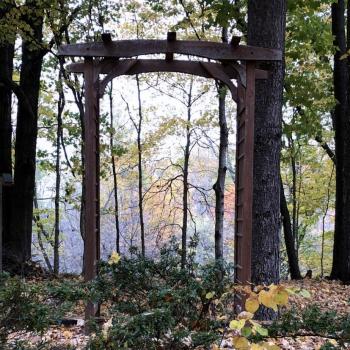Many of us have a keen desire to shelter and nurture our wild spaces. In earth-based spirituality, Sanctuaries are often designated places outdoors. Marine, tree, animal, and plant preserves, which are free from hunting or damaging development by humans, exist around the world.
Monarch butterflies migrate thousands of miles each year from Canada to Sanctuaries along the coast of California. With the help of humans, a Butterfly Sanctuary in Pacific Grove where I live was saved from development. Over the last few years the numbers of monarchs returning has plummeted. This has saddened many of us; yet we still celebrate the ones who do made the trip and pray for the completion of their regenerative cycle.
Samhain, mourning and celebrating together
This time of year is also one of the most sacred for earth-centered spirituality. It is when we open our hearts and provide comfort to one another, a form of Sanctuary. This last year has brought loss for so many. Intense hurricanes, floods, tornados, earthquakes and fires occurred more frequently as we experience on-going climate changes. The inter-relationship of devastation to the natural world and urban society has been widespread. While grief at overwhelming loss is dominant, mutual aid and remembering the good times is more common than would be expected.
Samhain and the autumn season call for regaining balance and rekindling hope, showing generosity and acceptance. In a spiritual sense, this important holiday can be an occasion when we remove ourselves from the pressures of daily life, catching an emotional and mental reprieve. This is an interlude when we mingle with others who may be strangers. In our neighborhoods and in our schools, costumes, parties and make believe continue. Children and adults are encouraged to have fun. Patheos has provided a free booklet that contains interesting myths, mysteries, historical information, activities and viewpoints about this cross-quarter holiday. It is beautifully produced, a celebration in itself.
The Festival of Fire (Samhain), booklet by Patheos
Sanctuaries as Places of Peace
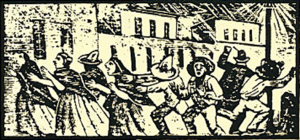 The word Sanctuary has come into common use in the national news as well. Historically, individuals seeking safety from persecution due to unjust laws took refuge in church buildings where they were insulated from prosecution by secular law enforcement. The church Sanctuary, the main chamber of worship, was considered a Safe Haven. It became a temporary home for those who swore they were wrongly accursed. Here they could find peace.
The word Sanctuary has come into common use in the national news as well. Historically, individuals seeking safety from persecution due to unjust laws took refuge in church buildings where they were insulated from prosecution by secular law enforcement. The church Sanctuary, the main chamber of worship, was considered a Safe Haven. It became a temporary home for those who swore they were wrongly accursed. Here they could find peace.
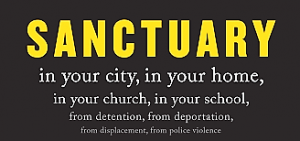 Today this designation is associated with shielding individuals from arrest and deportation by federal agents simply because of their immigration status. Many localities are declaring themselves Sanctuaries, announcing no one will be detained or deported only because they lack legal status documents. Concern, compassion and acceptance are qualities encouraged in these spaces. For me, these Sanctuaries carry the moral authority to protect those who reside there.
Today this designation is associated with shielding individuals from arrest and deportation by federal agents simply because of their immigration status. Many localities are declaring themselves Sanctuaries, announcing no one will be detained or deported only because they lack legal status documents. Concern, compassion and acceptance are qualities encouraged in these spaces. For me, these Sanctuaries carry the moral authority to protect those who reside there.
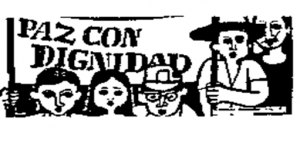 In the 1980s, the Sanctuary Movement was an inter-faith church effort to aid those who were fleeing from tyranny in their homelands, at that time countries in Central America. I was intensely involved in this movement in northern California. Our coalition of churches, synagogues, Buddhists and Unitarian Universalist congregations banded together to present educational events throughout our communities, both sacred and secular. We lobbied the U.S. Congress and provided direct aid to refugees. This effort was known nationwide and made a difference to many people fleeing oppression in their homelands. It brought the concept of Sanctuary to the attention of North Americans.
In the 1980s, the Sanctuary Movement was an inter-faith church effort to aid those who were fleeing from tyranny in their homelands, at that time countries in Central America. I was intensely involved in this movement in northern California. Our coalition of churches, synagogues, Buddhists and Unitarian Universalist congregations banded together to present educational events throughout our communities, both sacred and secular. We lobbied the U.S. Congress and provided direct aid to refugees. This effort was known nationwide and made a difference to many people fleeing oppression in their homelands. It brought the concept of Sanctuary to the attention of North Americans.
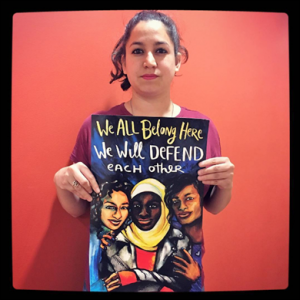 Today we have a widespread situation which goes beyond what Sanctuary was responding to in the 1980s. The concept has been taken up by non-religious government institutions as well as many spiritual ones. They are providing some safeguards for immigrants who may be deported even if they are employed and without criminal records.
Today we have a widespread situation which goes beyond what Sanctuary was responding to in the 1980s. The concept has been taken up by non-religious government institutions as well as many spiritual ones. They are providing some safeguards for immigrants who may be deported even if they are employed and without criminal records.
The rescinding of the Deferred Action for Childhood Arrivals program (DACA) is especially unfair. My last column Aren’t We All Dreamers? talks about this. These young people who have grown up in the United States and are fully integrated into U.S. Society are among the many in dire need of broad based community support.
Tonantzin and Virgin of Guadalupe
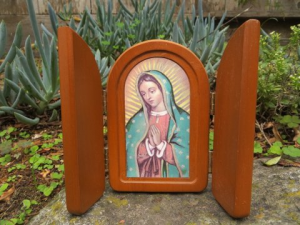 Empathy is an important aspect of this modern Sanctuary movement. Many who are participating in this movement have become familiar with Tonantzin, a major Earth deity for the indigenous people of Mexico. She provides protection and compassion to those in need.
Empathy is an important aspect of this modern Sanctuary movement. Many who are participating in this movement have become familiar with Tonantzin, a major Earth deity for the indigenous people of Mexico. She provides protection and compassion to those in need.
The Virgin of Guadalupe is a “Christianized” version of Tonantzin. She appeared at the site of Tonantzin’s main shrine only ten years after the Spanish conquest in 1531. The banner featuring Guadalupe was carried by the Farmworkers as they organized for their rights in the 1960s. While she is a many faceted icon with multiple meanings, I believe what Guadalupe stood for in the 1960s during the grape boycotts has a lot to do with what is happening in California today.
California is a Sanctuary State
 Multiculturalism is welcomed in California which is the most diverse State. Recently, the Legislature passed a bill which the governor signed making California a Sanctuary State. This means that laws that unfairly target immigrants will not be enforced by local and state officials in California. This does not mean that the federal authorities cannot come into the State but law enforcement organizations in California will not cooperate with their efforts.
Multiculturalism is welcomed in California which is the most diverse State. Recently, the Legislature passed a bill which the governor signed making California a Sanctuary State. This means that laws that unfairly target immigrants will not be enforced by local and state officials in California. This does not mean that the federal authorities cannot come into the State but law enforcement organizations in California will not cooperate with their efforts.
The current U.S. Attorney General Sessions has called these Sanctuary efforts nationwide “immoral.” Obviously there is a difference of belief about this. Those of us who provide Sanctuary consider our actions in line with a higher law, historical precedent and international laws, which we consider deeply moral.
Altars to Honor the Ancestors
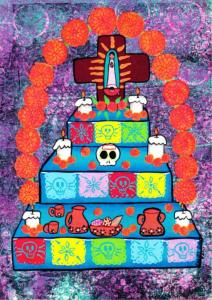 One of the gifts I receive from my work with people from Central and South America is participating in the Day of the Dead, celebrated on November first, which features brightly colored and fanciful altars that welcome the personal mementos of those we know who have died. I have set my own offerings on many such altars and have mingled with those who speak Spanish as their first language. I find this a deeply healing experience.
One of the gifts I receive from my work with people from Central and South America is participating in the Day of the Dead, celebrated on November first, which features brightly colored and fanciful altars that welcome the personal mementos of those we know who have died. I have set my own offerings on many such altars and have mingled with those who speak Spanish as their first language. I find this a deeply healing experience.
Skeletons are often pictured, calling us to get back to the essentials, to honor those who have passed through the veil and to appreciate one another during shared festivities. As a sign of respect and reverence for this process, the custom of building altars has spread to many of our churches as well. As we place keepsakes of our own beloved ones, let’s remember also those who gave so much to make this nation more just for everyone.
In closing, it seems to me, that a moral outlook calls us to show concern for the well-being of the global interconnected web. This demands a recasting of how we distribute resources, maintain the common good and appreciate our differences and our shared qualities. We have learned that trees, wild creatures, humans and pets who all live together in the path of the fire, wind, moving earth and water, and those who live in fear of persecution are intertwined.
Sanctuary for All may be the shorthand for this vision of creating places of peace in both the wildlands and the urban societies. In order to hold onto the spiritual balance that maintains our communities, we need now to trust rather than fear; show respect rather than skepticism; see the other as friend rather than suspect; and appreciate Nature as Home rather than resource.
Art Credits:
Monarch Butterflies courtesy of Robert Pacelli, photographer.
Guadalupe hand held altar, Photo by Bob Fisher
Para Los Muertos, “For the Dead” by Annette Armas, in the author’s collection. See her other Day of the Dead altar items at www.cjsangels.com
All other images are in the public domain.


